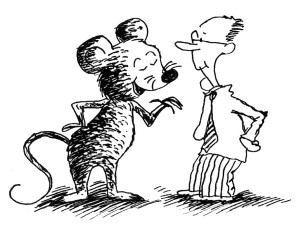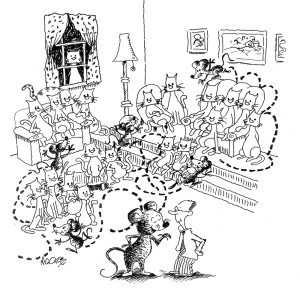Excerpts from
If You’ve Got to Herd Cats, You’ll Need a Big Mouse
By Bill Tenny-Brittian
 Excerpt: Chapter 1
Excerpt: Chapter 1
The board meeting was over and everyone had left the conference room but him and me. Kent was clearly frustrated. “I’d hoped to come away from this afternoon’s meeting with a clear idea about where Helping Hands wants to go, but honestly, after the last three hours I’m more confused than I was before.” Kent had just turned thirty-two, but he wore the weariness on his face and the frustration in his voice like someone nearly twice that. He leaned forward and cupped head in hands, massaging his temples with his thumbs. The conversation had taken a lot out of him.
“Sharon seems to think our mission is to grow our bank account for some sort of an end-of-the-world scenario, let alone a rainy day. On the other hand, Larry is pretty sure Helping Hand’s goal should be to spend down our assets to cure all the community’s ills. And Betty, Gordon, and Allen? They just want bigger, better, and more … whatever that means.”
“Don’t forget James and Robert who kept asking why you needed to make any changes at all.”
As his coach and business consultant, I didn’t envy Kent. He’d been hired as the CEO six months earlier and had spent those months trying to get to know the ins and outs of the organization.
If we’d learned anything, it was clear to us that Kent was awash in a mischief of good ideas. The listening sessions and the vision retreat proved that. But to help him see the reality of the situation, we asked him make a list of all the different ideas and visions and dreams he’d gathered from the stake holders. The result was a significant slate of oddments and notions – the heart and soul of the mischief. Each of the ideas, each “mouse” in the mischief, was seductive enough to entice a couple of institutional cats (staff members) to bolt after them in a merry chase. The result was an organization that was so busy chasing so many different dreams, visions, and ideas that it couldn’t get any traction to move forward at all. In fact, there wasn’t even any consensus on what forward meant.
===
Excerpt: Chapter 2
In most organizations you’ll find three kinds of mice that create problems for cats (the board members) and the cat herders (the CEO and executive team).
Cast of Characters
Rodent: Four Legged Critters that Have No Role in this Book.
Cats: Pretty much everyone in the organization, but especially the CEO, staff, board members, executive directors, and at times even the clients. Sometimes called Company Cats.
Cat Herders: The Organizational Leaders (including the CEO, staff, and the executive directors).
Mouse: An Idea (some good, some not-so-good).
Pet Mouse: A Board Cat’s Personal Good Idea (or not-so-good idea).
Rats: Bullies and Terrorists (former cats that have become so consumed by their own preferences and ideas – their personal pet mice – that they have mutated into board rats).
- The first kind of mouse is a rodent that can be eradicated by adopting a cat of the feline variety from your local animal shelter or else by getting a pest control contract with Orkin. Rodents rarely get in the way of cat herding.
- The second kind of mouse is a fast breeder, has a voracious appetite, and the rascal creates devilish distractions wherever it’s found. Indeed, this mouse is so notorious for its not-so-funny business that a collective of them are not called a pack or a herd of mice … they’re called a mischief of mice. In an NPO, each mouse is someone’s idea or vision or preference for how the organization ought to do things. Every board cat has a favorite pet mouse (or two!) and they’ll do everything in their power to get other cats to help chase it with them. The problem is, these mice … these ideas, visions, and preferences … take on lives of their own whenever they’re let loose. And whenever there’s a mischief of pet mice, there are cats chasing them every which way.
- Most organizations have a couple of the third kind of mice skulking around. They’re the company rats. Okay, technically they’re not mice, but when it comes to scuttling the mission and the good work of the organization these vermin pop up in the most inconvenient places at the most inconvenient times. Company rats were once company cats who became so consumed by their own “good ideas,” their pet mice took over and the cats mutated into rats. What’s worse, these rats grow so big and can be so vicious that they’ll chase even the most well-prepared cat down the hall and out of the board room door. These rats have been variously called board bullies or board terrorists.
Kent and the Helping Hands Community Center were suffering with two out of the three … which is pretty common. Wherever there’s a mischief of mice, there are at least a couple of rats keeping the cats scattered and scared. And even CEO Superman couldn’t herd scattered scaredy-cats – what hope would a mere mortal have?
===
Excerpt: Chapter 4
The real problem wasn’t which good idea to choose, but whether it was wise to make a choice at all. It seemed Kent only had two options:
- Make a choice and alienate the majority of the institutional cats; or
- Make no choice and forfeit the possibility of “forward progress” – whatever that would have looked like.
Kent looked up from the list. “The fact is, everyone has their own good idea about what’s next and what’s best for Helping Hands. Some probably haven’t shared their ideas at all. Some have shared their good ideas without much comment. There are a few who’ve been trying to build coalitions to get their ideas adopted. And there are a couple who will pretty much do anything they have to … including coercion … to get their ideas implemented. Everyone wants to go off in their own direction.”
“What would happen if you somehow managed to implement everyone’s good idea and still had resources left?”
Kent stared at the list and paused for awhile. The magnitude of the problem began to dawn on him. It wouldn’t matter whether he implemented all the good ideas on the list or not. Once he had, those pesky mice would just multiply and he’d have another list of good ideas demanding to be chased. It was as if he was playing a game of Whack-A-Mole. If he brained one mouse, another one or two or ten would pop up every time. Of good ideas, there would be no end.
 “The problem isn’t that your stakeholders have lots of good ideas. That’s actually a good thing. It means you have people willing to be engaged on some level. But engaged in what and to what end? Everyone has an opinion and everyone has a good idea. If you want to launch a movement, you’ve got to have an idea that’s so good – that’s so great – that it towers over and above all the other good ideas.
“The problem isn’t that your stakeholders have lots of good ideas. That’s actually a good thing. It means you have people willing to be engaged on some level. But engaged in what and to what end? Everyone has an opinion and everyone has a good idea. If you want to launch a movement, you’ve got to have an idea that’s so good – that’s so great – that it towers over and above all the other good ideas.
“Do you remember your comment about trying to herd cats? Well, there’s only one way to herd cats: you’ve got to get a bigger mouse.”
Whenever a big enough mouse steps into the room, every cat turns its head to size it up. If it’s a big enough mouse, the cats lose interest in their own pet ideas and begin to move as one toward the really big good idea. There’s a name for that kind of really big good idea: we call it vision. Jim Collins of Built to Last fame named his big mouse BHAG – Big Hairy Audacious Goal. But no matter what you call it, to captivate and herd institutional cats the good idea has to be more than just a good idea … it has to be visionary enough that everyday ideas disappear beneath its shadow.
It turns out most good ideas are just detours and distractions. It’s an unfortunate part of life that as we travel toward a promising future, a seemingly innocent good idea will pop up and entice us to chase it. When we do, we’ve become the proverbial cat that chases a mouse. That mouse – that distraction, that good idea – keeps us from reaching our dreams.
===
Ready to discover your big mouse vision and put it into play?
